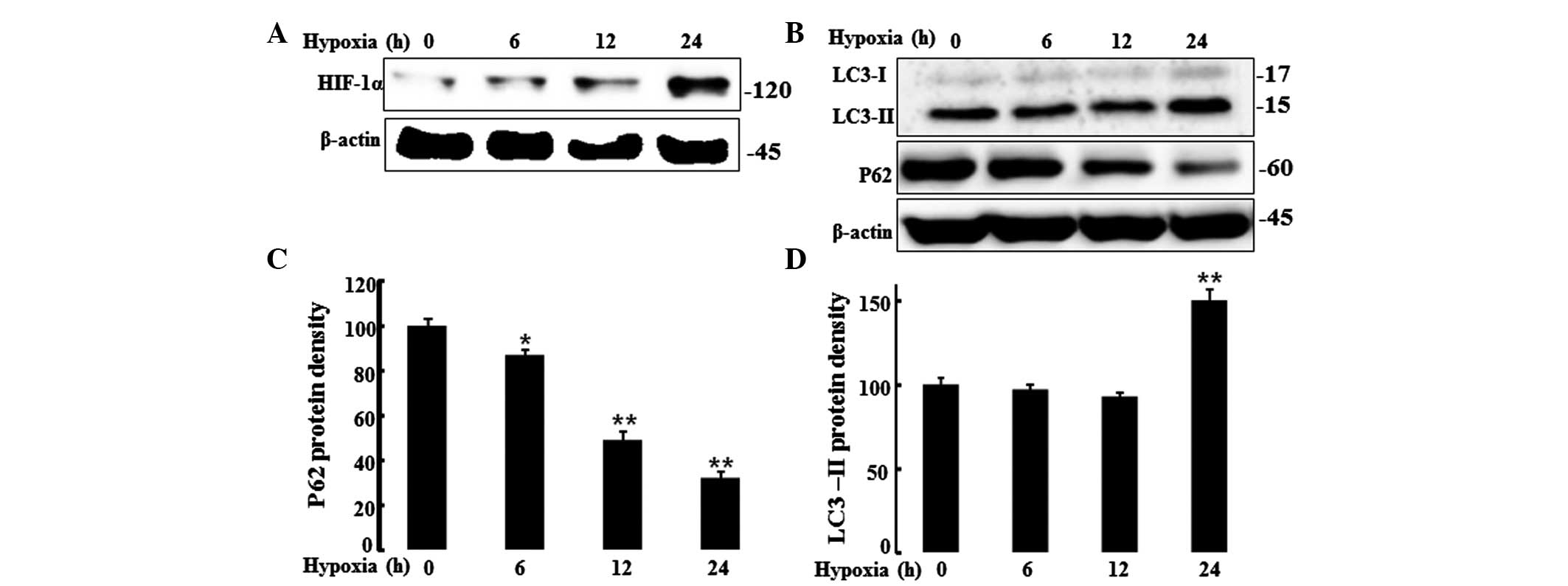|
1
|
Johnstone RW, Frew AJ and Smyth MJ: The
TRAIL apoptotic pathway in cancer onset, progression and therapy.
Nat Rev Cancer. 8:782–798. 2008. View
Article : Google Scholar : PubMed/NCBI
|
|
2
|
Wu NL, Lee TA, Tsai TL and Lin WW:
TRAIL-induced keratinocyte differentiation requires caspase
activation and p63 expression. J Invest Dermatol. 131:874–883.
2011. View Article : Google Scholar : PubMed/NCBI
|
|
3
|
Li JH, Kirkiles-Smith NC, McNiff JM and
Pober JS: TRAIL induces apoptosis and inflammatory gene expression
in human endothelial cells. J Immunol. 171:1526–1533. 2003.
View Article : Google Scholar : PubMed/NCBI
|
|
4
|
Semenza GL: Hypoxia-inducible factor 1:
control of oxygen homeostasis in health and disease. Pediatr Res.
49:614–617. 2001. View Article : Google Scholar : PubMed/NCBI
|
|
5
|
Hu Y, Kirito K, Yoshida K, Mitsumori T,
Nakajima K, Nozaki Y, Hamanaka S, Nagashima T, Kunitama M, Sakoe K
and Komatsu N: Inhibition of hypoxia-inducible factor-1 function
enhances the sensitivity of multiple myeloma cells to melphalan.
Mol Cancer Ther. 8:2329–2338. 2009. View Article : Google Scholar : PubMed/NCBI
|
|
6
|
Kaelin WG Jr: Treatment of kidney cancer:
insights provided by the VHL tumor-suppressor protein. Cancer.
115(Suppl 10): S2262–S2272. 2009. View Article : Google Scholar
|
|
7
|
Tandara AA and Mustoe TA: Oxygen in wound
healing-more than a nutrient. World J Surg. 28:294–300. 2004.
View Article : Google Scholar : PubMed/NCBI
|
|
8
|
LaVan FB and Hunt TK: Oxygen and wound
healing. Clin Plast Surg. 17:463–472. 1990.PubMed/NCBI
|
|
9
|
Evans NT and Naylor PF: The systemic
oxygen supply to the surface of human skin. Respir Physiol.
3:21–37. 1967. View Article : Google Scholar : PubMed/NCBI
|
|
10
|
Stewart FA, Denekamp J and Randhawa VS:
Skin sensitization by misonidazole: a demonstration of uniform mild
hypoxia. Br J Cancer. 45:869–877. 1982. View Article : Google Scholar : PubMed/NCBI
|
|
11
|
Stucker M, Struk A, Altmeyer P, Herde M,
Baumgärtl H and Lübbers DW: The cutaneous uptake of atmospheric
oxygen contributes significantly to the oxygen supply of human
dermis and epidermis. J Physiol. 538:985–994. 2002. View Article : Google Scholar : PubMed/NCBI
|
|
12
|
Pursiheimo JP, Rantanen K, Heikkinen PT,
Johansen T and Jaakkola PM: Hypoxia-activated autophagy accelerates
degradation of SQSTM1/p62. Oncogene. 28:334–344. 2009. View Article : Google Scholar
|
|
13
|
Levine B and Kroemer G: Autophagy in the
pathogenesis of disease. Cell. 132:27–42. 2008. View Article : Google Scholar : PubMed/NCBI
|
|
14
|
Delgado MA, Elmaoued RA, Davis AS, Kyei G
and Deretic V: Toll-like receptors control autophagy. EMBO J.
27:1110–1121. 2008. View Article : Google Scholar : PubMed/NCBI
|
|
15
|
Hussey S, Travassos LH and Jones NL:
Autophagy as an emerging dimension to adaptive and innate immunity.
Semin Immunol. 21:233–241. 2009. View Article : Google Scholar : PubMed/NCBI
|
|
16
|
Zhao Y, Zhang CF, Rossiter H, Eckhart L,
König U, Karner S, Mildner M, Bochkov VN, Tschachler E and Gruber
F: Autophagy is induced by UVA and promotes removal of oxidized
phospho-lipids and protein aggregates in epidermal keratinocytes. J
Invest Dermatol. 133:1629–1637. 2013. View Article : Google Scholar : PubMed/NCBI
|
|
17
|
Lee HM, Shin DM, Yuk JM, Shi G, Choi DK,
Lee SH, Huang SM, Kim JM, Kim CD, Lee JH and Jo EK: Autophagy
negatively regulates keratinocyte inflammatory responses via
scaffolding protein p62/SQSTM1. J Immunol. 186:1248–1258. 2011.
View Article : Google Scholar
|
|
18
|
Seo JS, Seol JW, Moon MH, Jeong JK, Lee YJ
and Park SY: Hypoxia protects neuronal cells from human prion
protein fragment-induced apoptosis. J Neurochem. 112:715–722. 2010.
View Article : Google Scholar
|
|
19
|
Candi E, Rufini A, Terrinoni A, Dinsdale
D, Ranalli M, Paradisi A, De Laurenzi V, Spagnoli LG, Catani MV,
Ramadan S, et al: Differential roles of p63 isoforms in epidermal
development: selective genetic complementation in p63 null mice.
Cell Death Differ. 13:1037–1047. 2006. View Article : Google Scholar : PubMed/NCBI
|
|
20
|
Eberle J, Fecker LF, Forschner T, Ulrich
C, Röwert-Huber J and Stockfleth E: Apoptosis pathways as promising
targets for skin cancer therapy. Br J Dermatol. 156(Suppl 3):
18–24. 2007. View Article : Google Scholar : PubMed/NCBI
|
|
21
|
Mora R, Abschuetz A, Kees T, Dokic I,
Joschko N, Kleber S, Geibig R, Mosconi E, Zentgraf H,
Martin-Villalba A and Régnier-Vigouroux A: TNF-alpha- and
TRAIL-resistant glioma cells undergo autophagy-dependent cell death
induced by activated microglia. Glia. 57:561–581. 2009. View Article : Google Scholar
|
|
22
|
Herrero-Martín G, Høyer-Hansen M,
García-García C, Fumarola C, Farkas T, López-Rivas A and Jäättelä
M: TAK1 activates AMPK-dependent cytoprotective autophagy in
TRAIL-treated epithelial cells. EMBO J. 28:677–685. 2009.
View Article : Google Scholar : PubMed/NCBI
|
|
23
|
Itakura E and Mizushima N: p62 Targeting
to the autophagosome formation site requires self-oligomerization
but not LC3 binding. J Cell Biol. 192:17–27. 2011. View Article : Google Scholar : PubMed/NCBI
|
|
24
|
Singh K, Sharma A, Mir MC, Drazba JA,
Heston WD, Magi-Galluzzi C, Hansel D, Rubin BP, Klein EA and
Almasan A: Autophagic flux determines cell death and survival in
response to Apo2L/TRAIL (dulanermin). Mol Cancer. 13:702014.
View Article : Google Scholar : PubMed/NCBI
|













